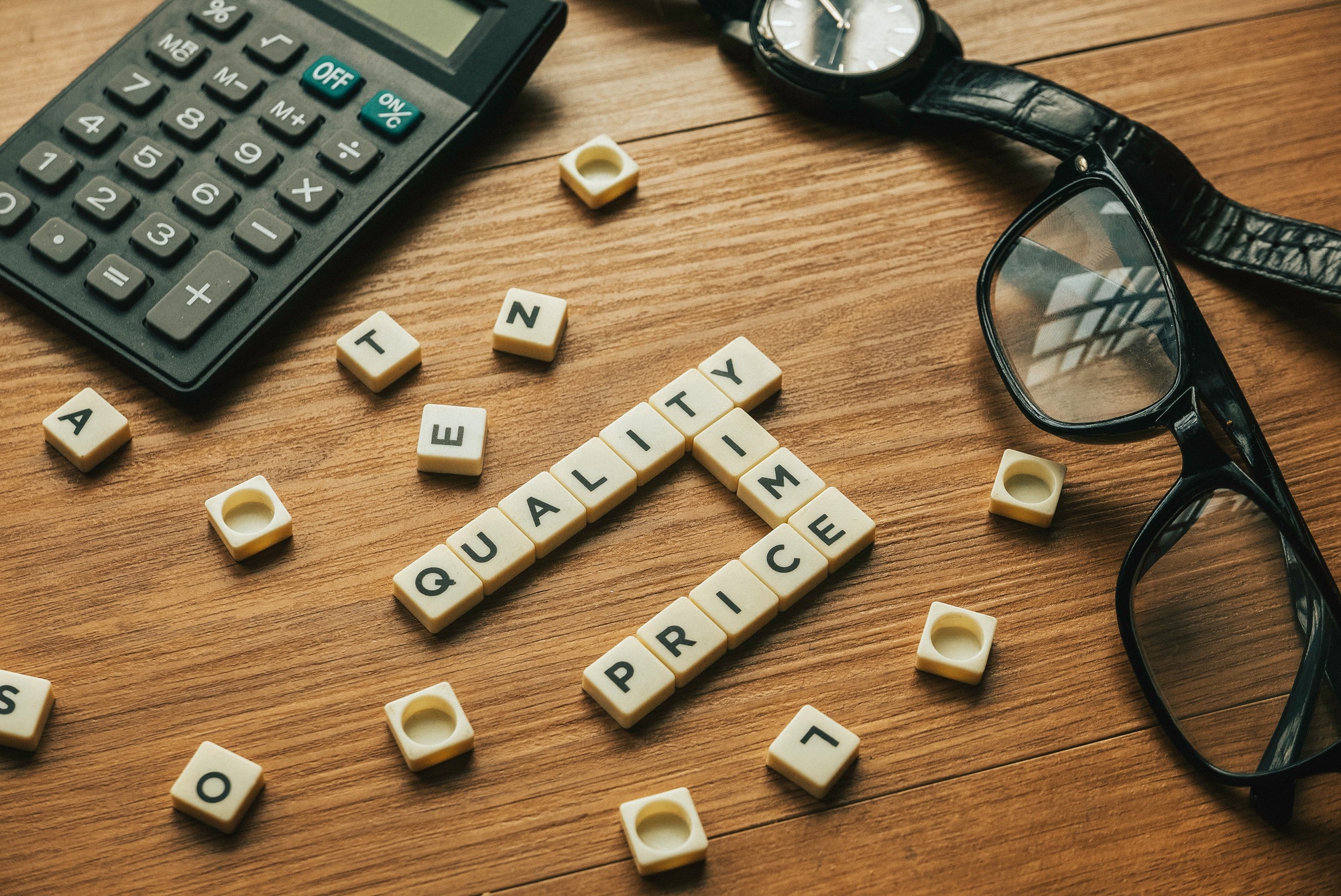Comprehending break-even price is fundamental for evaluating your business’s financial viability. It involves calculating your total fixed and variable costs, and determining how these figures relate to your pricing strategy. By grasping the break-even concept, you can make informed decisions that directly impact profitability. With that foundation, you’ll want to explore the specific formulas and examples that clarify this concept further, ensuring you’re equipped to optimize your financial outcomes effectively.
Key Takeaways


- Break-even price is the point where total revenue equals total costs, resulting in no profit or loss for a business.
- For product sales, calculate break-even price using the formula: Fixed Costs / Contribution Margin (Selling Price – Variable Cost).
- In options trading, break-even price differs: for calls, it’s strike price plus premium; for puts, it’s strike price minus premium.
- Including taxes and fees in calculations ensures accurate assessments of profitability and avoids underestimating required sales volumes.
- Regularly reviewing break-even prices aids in financial planning, helps set pricing strategies, and assesses investment viability.
What Is a Break-Even Price?
A break-even price is a critical financial concept that indicates the point where total revenue equals total costs, resulting in neither profit nor loss. Comprehending the break-even price meaning is vital for businesses to evaluate their pricing strategies and set realistic sales targets.
To find this price, you need to add your fixed costs to your variable costs and determine the necessary price to cover them.
In options trading, calculating the break-even price differs for call and put options; for call options, it’s the strike price plus the premium paid, whereas for put options, it’s the strike price minus the premium paid.
This analysis helps you decide on production levels, as higher production can lower the break-even price by spreading fixed costs across more units.
Key Takeaways


Grasping the break-even price offers valuable insights into a business’s financial health and operational strategies. Comprehending this concept is fundamental for effective decision-making.
Here are some key takeaways:
- The break-even price indicates where total revenue equals total costs, meaning no profit or loss occurs.
- It’s critical for setting sales targets and pricing strategies, ensuring your business stays competitive.
- In options trading, the break-even point for options differs: for a call option, it’s the strike price plus the premium paid, whereas for a put option, it’s the strike price minus the premium.
Regularly updating your break-even analyses with current financial data is significant for maintaining accurate insights into profitability and cost management.
Understanding Break-Even Prices
Grasping break-even prices is essential for effective financial management in any business. The break-even price represents the point where total revenue equals total costs, resulting in neither profit nor loss. Comprehending this concept helps you make informed pricing and production decisions.
For instance, in options trading, calculating break-even prices involves different methods for call and put options. For a call option, you add the strike price to the premium paid, whereas for a put option, you subtract the premium from the strike price.
Break-Even Price Formula

To understand the break-even price formula, it’s important to distinguish between fixed and variable costs.
You can calculate the break-even price for product sales by dividing the sum of total fixed costs and total variable costs by the number of units sold.
In options trading, the calculations differ slightly, as the break-even price for a call option adds the premium to the strike price, whereas a put option subtracts the premium from the strike price.
Formula for Product Sales
Grasping the break-even price formula is crucial for any business looking to assess the viability of its products. To calculate the break-even price, you’ll divide your Total Fixed Costs by the contribution margin, which is the Selling Price per Unit minus Variable Cost per Unit. This helps you determine how many units you need to sell to cover your costs.
Here are some key points about break-even price options:
- It identifies the minimum sales volume to avoid losses.
- You can find total revenue needed by multiplying break-even quantity by the selling price.
- A clear comprehension aids in effective pricing strategies and cost management.
Using this formula guarantees you’re better equipped to evaluate your product’s financial viability.
Options Contract Calculations
Options contracts are a unique financial instrument that require careful calculation of break-even prices to guarantee profitability. Comprehension of the break-even point of call options and put options is crucial for making informed trading decisions.
Here’s a simple breakdown:
| Option Type | Calculation | Example |
|---|---|---|
| Call Option | Strike Price + Premium | $50 + $5 = $55 (Break-even) |
| Put Option | Strike Price – Premium | $30 – $2 = $28 (Break-even) |
| Total Costs | Break-even ± Commissions/Taxes | Adjust based on additional fees |
| Profitability | Price Movement Needed | Determines exercise decision |
| Risk Assessment | Crucial for evaluating trades | Helps avoid losses |
Fixed vs. Variable Costs
Comprehension of fixed and variable costs is fundamental when calculating the break-even price, as these costs shape pricing strategies and overall profitability.
Fixed costs remain constant regardless of production levels, whereas variable costs fluctuate based on production volume. Here are some key points to reflect on:
- Fixed costs include rent, salaries, and insurance.
- Variable costs encompass materials and direct labor, changing with sales volume.
The break-even price formula, Break-Even Price = (Total Fixed Costs + Total Variable Costs) / Total Units Sold, helps you determine your minimum sale price to cover expenses.
Understanding these distinctions is critical for accurate breakeven price options, as they directly impact your pricing strategies and profitability assessments.
This knowledge allows you to manage costs effectively, leading to quicker profitability.
Examples of Break-Even Prices
How can comprehension of break-even prices benefit your decision-making in business? Grasping examples helps you apply these concepts effectively.
For instance, if a company incurs fixed costs of $200,000 and variable costs of $10 per widget, selling 10,000 widgets at a break-even price of $30 guarantees all expenses are met.
In real estate, if you buy a house for $300,000 with $60,000 in supplementary costs, your break-even price is $360,000, which covers all expenses upon sale.
Moreover, in options trading, knowing what’s breakeven in options means that if your call option has a strike price of $50 and a premium of $5, the break-even price is $55, allowing you to assess potential profitability effectively.
Break-Even Price for an Options Contract

Comprehending break-even prices in various business contexts lays the groundwork for evaluating options contracts. For a call option, the break-even price is the sum of the strike price and the premium paid. Conversely, for a put option, it’s found by subtracting the premium from the strike price.
Grasping this concept is essential for options traders as it defines the minimum price an asset must reach for the trade to be profitable.
Here are some key points to remember:
- Break-even price for a call = strike price + premium.
- Break-even price for a put = strike price – premium.
- Accurate calculations assist in making informed decisions about exercising or selling options.
Why Should Taxes and Fees Be Included in a Break-Even Analysis?

When you include taxes and fees in your break-even analysis, you get a clearer picture of your true costs, which is essential for accurate profit calculations.
By factoring in these expenses, you can assess your financial situation thoroughly and avoid underestimating the sales volume needed to reach profitability.
This insight helps you make informed decisions and maintain healthy cash flow for your business.
Profit Calculation Accuracy
Including taxes and fees in your break-even analysis is essential for achieving an accurate comprehension of your profitability. If you overlook these elements, you may misinterpret what does break even mean in options.
Here are a few reasons to include them:
- Long-term capital gains tax can greatly reduce your net profits from sales.
- Commission fees, like $1 per trade, directly affect your net revenue from each transaction.
- State and local taxes can alter your financial environment, impacting overall calculations.
Comprehensive Financial Assessment
A thorough financial assessment requires careful consideration of all costs associated with your business operations, especially taxes and fees.
Including taxes in your break-even analysis is essential, as they can greatly reduce net profits, eventually affecting your profitability calculations. Fees, such as transaction and commission costs, directly impact your effective return on investment; overlooking these can lead to an overestimation of potential profits at the break-even point.
Furthermore, long-term capital gains taxes must be factored in, as they can erode the profitability of asset sales.
How Can Ordinary Individuals Use Break-Even Prices?

How can you leverage break-even prices in your daily financial decisions? Comprehending break-even prices can empower you to make informed choices about your finances. Here’s how you can use them effectively:
- Selling Personal Items: Calculate the minimum sale price needed to cover your costs, including repairs and original purchase price.
- Starting a Side Business: Assess your fixed and variable costs against expected sales prices to determine financial viability.
- Investing in Stocks or Options: Learn what does breakeven mean in options to find the price point at which you recover your investment after fees.
Frequently Asked Questions
What Is Break-Even Pricing in Simple Words?
Break-even pricing is simply the point where your total revenue equals your total costs, meaning you neither gain nor lose money.
It includes both fixed costs, like rent and salaries, and variable costs, such as materials and labor.
To find this price, you can use the formula: break-even price equals total fixed costs divided by the number of units, plus the variable cost per unit.
This comprehension helps you set prices effectively.
How to Do a Break-Even Analysis Step by Step?
To perform a break-even analysis, start by identifying your fixed costs, like rent and salaries.
Then, calculate your variable costs that change with production volume.
Next, find the contribution margin per unit by subtracting variable costs from the selling price.
Use the formula: Break-Even Point (Units) = Total Fixed Costs / Contribution Margin per Unit to determine how many units you need to sell.
Finally, multiply the break-even units by the selling price to find your break-even revenue.
What Does Breakeven Price Mean?
Breakeven price is the point where your total revenue matches your total costs, meaning you neither gain nor lose money.
It includes fixed costs, which remain constant, and variable costs, which change with production levels.
Knowing this price helps you set effective pricing strategies and assess whether your products are viable in the market.
What Is Bep in Simple Words?
BEP, or Break-Even Point, is the sales level where your total revenue matches your total costs.
In simpler terms, it’s the point where you neither make a profit nor incur a loss.
To find your BEP, you divide your total fixed costs by the difference between the sales price per unit and the variable cost per unit.
Knowing your BEP helps you understand the minimum sales needed to cover all your expenses.
Conclusion
In conclusion, comprehending break-even pricing is crucial for managing your business’s financial health. By calculating total fixed and variable costs, and determining your contribution margin, you can accurately assess the minimum sales volume needed to cover expenses. This analysis not just aids in pricing strategy but furthermore empowers you to make informed financial decisions. Whether you’re a business owner or an investor, grasping break-even concepts can greatly improve your ability to achieve profitability and sustainability.
Image Via Envato






